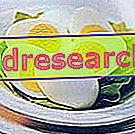Types of masks
DIY face masks are excellent beauty treatments, simple to prepare and extremely affordable (in the face of the expensive face masks regularly performed in beauty farms). With clay, strawberries, cucumber, yogurt, honey, lemon, pumpkin ... and so on and so forth: there are countless combinations of active ingredients that can be devised for a perfect face mask. at your place.

Advantages
Do-it-yourself face masks - and, more generally, all types of face masks - are very beneficial beauty treatments because the skin benefits on several fronts:
- The chemical-physical properties of the functional ingredients contained within the product are exploited.
- The superficial mechanical action exerted during the removal of the face mask favors the elimination of superficial corneal cells, thus making the skin more luminous, purified and smoothed.
- These beauty treatments promote the absorption of other active ingredients and nutrients applied immediately after the face mask.
- They stimulate the microcirculation thanks to the massage performed during their application and removal. The microcirculation can
- They give a pleasant regenerating perception to the skin.
In addition to what has just been stated, do-it-yourself face masks have another great advantage compared to face masks that can be purchased in perfumery or those performed in beauty salons, that is, they are inexpensive, since a few simple and easily available ingredients are sufficient to make them. relatively low cost.
Indications
When is it useful to apply a DIY face mask?
DIY face masks can be useful in all those moments when the skin of the face needs a shock treatment that brings it back to its optimal condition.
Depending on the ingredients that are used in the preparation phase, facial masks can be obtained suitable for treating various "disorders" and imperfections that can alter the skin of the face.
In detail, DIY face masks are particularly useful in the event of:
- Dry or very dry skin;
- Leather with a tendency to flake off;
- Dull, graying, and dim light;
- Impure skin, with large pores, blackheads and / or acne tendency;
- Inelastic skin that shows the first signs of aging.
Mode of use
The use of DIY face masks is rather trivial, but to obtain the desired effect it is necessary to put into practice some small tricks.
First of all, before applying the mask, it is necessary to gently cleanse the skin, eliminating any residue of make-up, sweat and dirt by adequate cleaning of the face .
Cleaning can be carried out with special make-up removers, delicate cleansers for the face, or with micellar water.

The mask must be applied to the face with a brush with soft bristles, or with the fingertips, taking care to gently massage the skin.
Once the laying time has elapsed (usually, ranging from 5 to 15 minutes), the mask must be removed with warm water. If desired, this operation can be carried out with the aid of a soft sponge.
After removing the product from the face, to prolong the purifying, moisturizing, emollient or lightening effect of the DIY mask, we recommend applying a generous layer of cream (nourishing, anti-wrinkle, emollient, anti-aging, etc.) to keep what longer soft, moisturized and radiant skin.
For example:
- The application of an acne cream formulated with active ingredients with a purifying and astringent action is indicated after a DIY clay mask to improve the appearance of oily and impure skin;
- A hyaluronic acid cream is particularly effective after applying a do-it-yourself anti-aging mask to deeply moisturize mature skin, while counteracting the formation of small wrinkles;
- A glycolic acid cream is indicated in the treatment of spots on the skin after applying a DIY mask with a lightening action (prepared for example with strawberries, grapes or other fruits particularly rich in malic acid).
Preparation
Clear ideas are needed to prepare a DIY face mask. It is first of all important to know your skin type (sensitive, normal, oily, dry skin, etc.), therefore choose the natural base (vehicle) in which the other functional principles will be dispersed. Also the choice of the assets is important, and must be subordinated to the imperfection or the disorder to treat / improve.
Vehicle selection

As a basis for a DIY face mask, we can choose between:
- Clay (white, red, green): it is particularly indicated for the treatment of oily and acneic skin. White clays can also be used for sensitive skin. In addition to being a vehicle in which to dissolve the active substances, in some cases, the clay can itself constitute the main active ingredient. To learn more, see the "Clay Mask" article.
- Yogurt : do-it-yourself yogurt face masks are undoubtedly the most suitable for sensitive and delicate skin. Often, the yogurt masks are enriched with honey (softening) and / or olive oil (protective, anti-wrinkle and sebum-restoring properties).
- Fruit : fruit acids revitalize the skin while acting as excellent lighteners to eliminate or lighten the unsightly hyperpigmented spots. Generally, the fruit pulp (strawberries, grapes, apples, etc.) is associated with oatmeal or muesli, useful both for "drying" the fruit liquid, and for enhancing the exfoliating action exerted by alpha-hydroxy acids contained in the pulp.
Choice of active ingredients and functional substances
The active ingredients to be incorporated into the vehicle vary depending on the imperfection or disorder that you want to treat.
There are many natural products that can be used: rose water, orange blossom water, lavender essential oil, rose oil, bitter orange oil, jojoba liquid wax, chamomile, black tea, aloe vera gel ... just a little imagination (and a general knowledge of the therapeutic virtues of plant extracts) to make DIY face masks with excellent beneficial properties. Try our recipes »



